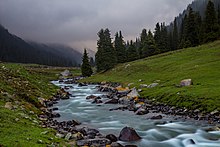Karakol
A Russian military outpost founded on 1 July 1869, Karakol grew in the 19th century after explorers came to map the peaks and valleys separating Kyrgyzstan from China.
In 1888, the Russian explorer Nikolay Przhevalsky died in Karakol of typhoid, while preparing for an expedition to Tibet; the city was renamed Przhevalsk in his honor.
[12] The main composition of the coat of arms and the flag consists of elements of the sun and the head of a deer with horns (symbols of the Buğu tribe).
Karakol is one of Kyrgyzstan's major tourist hubs, serving as a starting point for the hiking, trekking, skiing and mountaineering groups of the high central Tian Shan to the south and east.
Additionally, the city is quite culturally-rich, with several distinct ethnic groups present, such as Dungans, Kalmyks, Russians, Uyghurs, Uzbeks, and of course the local Kyrgyz.
The cathedral was originally built of stone, in 1872,[14] when Karakol was a garrison town established as an outpost on the edges of the Tsarist Russian Empire.
Then, in 1991 (following the collapse of the Soviet Union and the independence of Kyrgyzstan), the local authorities again gave the building back to the Church, whom assumed responsibility for all future remodeling and structural endeavors.
The Issyk-kul Central Mosque of Karakol was built for the local Dungan community through an initiative of Ibrahim Aji in the early 20th century.
Aji commissioned the famed Beijing architect Chou Seu, along with 20 workers (all skilled in traditional Chinese architecture), with building the mosque.
Nikolay Przhevalsky was one of the first Russian scientists, naturalists and geographers to commence detailed studies of the geography, flora and fauna of the Central Asian countries.
In 1888, he died from typhoid fever on the eve of his fifth expedition to Central Asia; he was buried on the Issyk-Kul lakeside, not far from the city of Karakol.
During the turbulent years of 1918–20 the building earned its socialist stripes as headquarters of the Regional Revolutionary Committee, and was subsequently transformed into a museum by order of the Soviet Council of Ministers in 1948.
Scythian artifacts include enormous bronze pots retrieved from Lake Issyk-Kul, displayed alongside exhibits on petroglyphs in the area.
On early Sunday mornings, one of Kyrgyzstan's biggest farmer’s markets and live animal auctions takes place, around 2 km north of central Karakol, with locals loading livestock in and out of the backs of sedans not being an uncommon sight.
Jostle through the chaos to reach a bigger main compound one block north, where horses and embossed leather saddlery are for sale.








